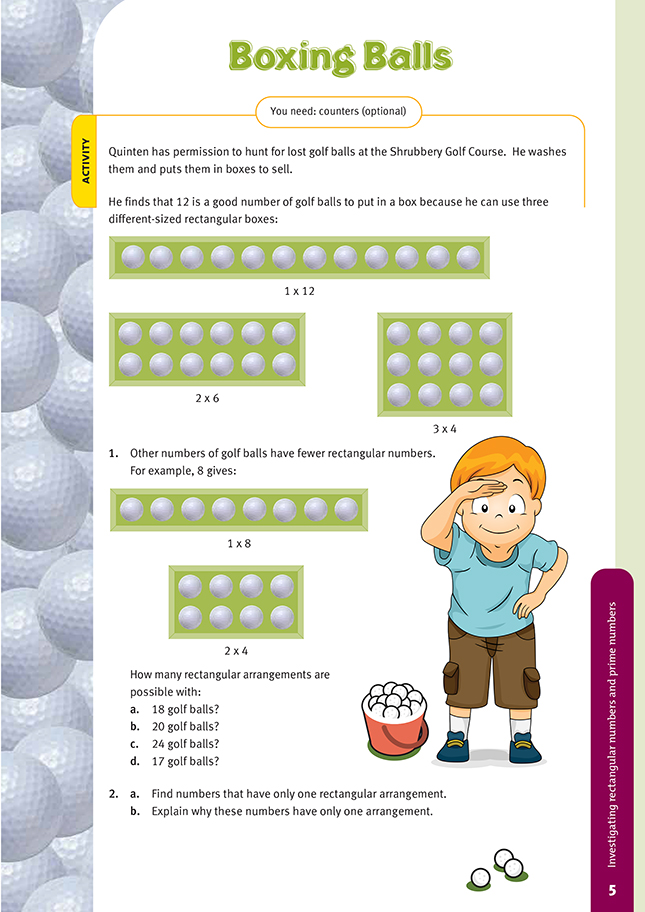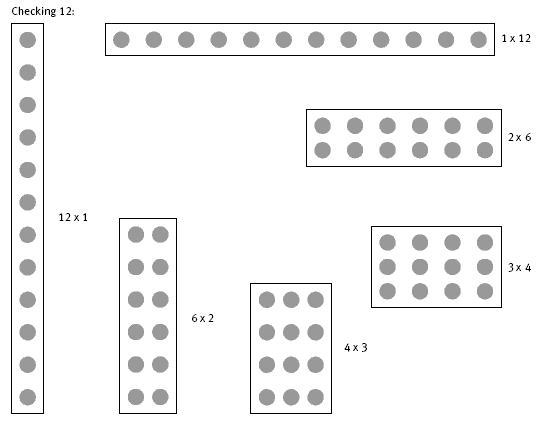This is a level 5 number link activity from the Figure It Out series. It relates to Stage 8 of the Number Framework.
A PDF of the student activity is included.
Click on the image to enlarge it. Click again to close. Download PDF (212 KB)
investigate prime and composite numbers
FIO, Link, Number, Book Four, Boxing Balls, page 5
Counters (optional)
In this activity, the students can manipulate concrete objects or drawings to explore the physical relationship between prime and composite numbers. They will become aware of how prime numbers can only be represented by single-row rectangles, whereas composite numbers have two or more possibilities. The activity also provides an opportunity to introduce a further strategy for quickly finding the factors of a larger number and checking if a number is prime.
As an introduction, you could have the students pair up to find out how many rectangular patterns can be made for 12. Record the patterns on the board. Note that patterns of 1, 2, 3, 4, 6, and 12 rows can be made but that half of them are the same pattern turned 90 degrees. The students can compare this with the patterns
for 8 and then, in pairs, complete the rectangular patterns for question 1. They can record their answers by shading them on grid paper and labelling their shadings with matching equations.
The students need to know how they can be sure that they have found all the arrangements (factors) of a number. This challenge should be explored during teacher support time and when you have the follow-up discussion. Possible questions are:
“Do you need to try out all the numbers to find all the factors?”
“Where can you stop checking to be certain you have found all the factors?”
“Which type of rectangle shows that a number is prime?”
“Which number has the fewest factors? … the most factors?” and so on.
By exploring the problem with counters, cubes, or diagrams, the students may come to discover that checking up to the square root of a number is sufficient and that if they find no factors other than 1 and the number itself, they can be sure the number is prime. You can demonstrate this, if necessary, by structuring a progression of factors on an overhead projector using transparent counters.
Once past 3, the factors begin to repeat themselves, and that is how you know that you have found them all.
This idea of repetition will help with question 2, where the students can check numbers quickly on a calculator up to the square root, which can also be determined on the calculator: 149 √.
Prime numbers have only two factors, themselves and 1, so rectangles beyond a single row cannot form
prime numbers. There will always be one or more left over. For example, for the prime number 11:
Answers to Activity
1. a. Three arrangements: 1 x 18, 2 x 9, 3 x 6
b. Three arrangements: 1 x 20, 2 x 10, 4 x 5
c. Four arrangements: 1 x 24, 2 x 12, 3 x 8, 4 x 6
d. One arrangement: 1 x 17
2. a. Numbers with one arrangement are:
1, 2, 3, 5, 7, 11, 13, 17, 19, 23, and all other prime numbers.
b. They are prime numbers and have only two factors, themselves and 1. For example, 13 = 13 x 1, 5 = 5 x 1.


